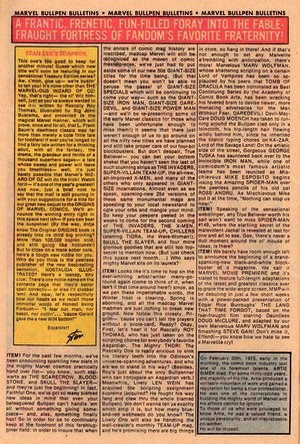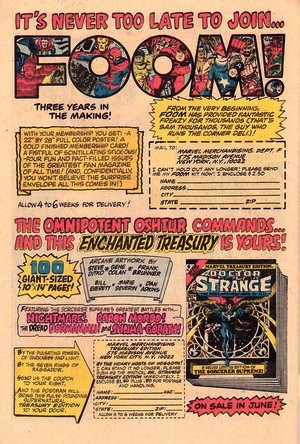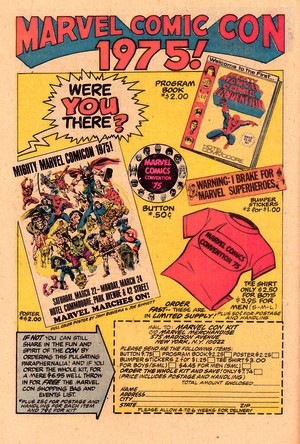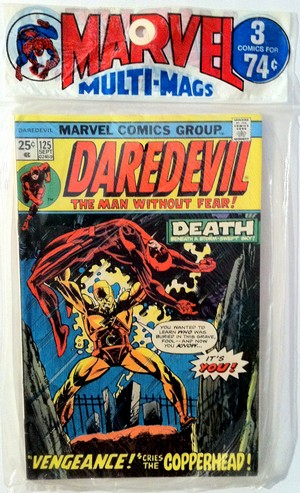DAREDEVIL, MAN THING &
CAPTAIN AMERICA |
|||||
 |
|||||
|
|||||
| This mid-Bronze Age MARVEL MULTI-MAG also serves as an example to
illustrate the fact that comic books coming from Marvel
were, at face value, much less suited for this format
than the superhero titles from DC. Whereas the latter
publisher's comic books still featured episodic
"done in one" adventures which had little to no
effect on following issues throughout the 1970s, the
continuity of the Marvel Universe was (literally) an
entirely different story: both the Daredevil and
Man-Thing comic books from this MULTI-MAGS wrap up stories which kicked off in
their respective previous issue, and the Captain
America book ends with a cliffhanger and a
"continued next issue" blurb. However, one needs to bear in mind also that this was a common fate of the average comic book reader in the 1970s Bronze Age, whether his or her comic books came packaged in a plastic bag or as single issues from a display or spinner rack. In those days, an uninterrupted supply of specific titles simply was not guaranteed, and one quickly became quite adept at not feeling too worried over possible gaps in storylines. And sometimes, such as in Captain America #189, you even got a recap of several preceding issues on one page. It simply was all a part of being a comic book fan in the 1970s - just as the monthly Bullpen Bulletins and in-house advertising were. |
|||||
   |
|||||
| The Bullpen Bulletin ("A
frantic, frenetic, fun-filled foray into the
fable-fraught fortress of fandom's favorite
fraternity!") was included in all Marvel's
titles, this time around including announcements by Stan
Lee of an upcoming Treasury Edition of the Wizard of
Oz, the non-publication of some previously announced
50¢
Giant-Size titles, various new scripting and art
assignments on various titles - and the passing of Artie
Simek (6 January 1916 -
20 February 1975), letterer supreme. Also included in all three comic packs in this MARVEL MULTI-MAGS was the combined FOOM / Giant-Size Doctor Strange advert, whereas only Daredevil and Man-Thing also ran the 1975 Marvel Comic-Con merchandising ad. |
|||||
|
|||||
| When Daredevil tracks down
Copperhead, Chesney explains that his father became
embittered due to the lack of royalties (he posed as the
model for the Copperhead covers) and ultimately went
insane and died when the pulp stories were being
reprinted and recirculated. Attempting to attack
Daredevil once more, Copperheadcis suddenly struck down
by a bolt of lightning and killed. In a final twist of
events, the Man without Fear tosses two pennies that land
over Copperhead's eyes. A slick story featuring a visually interesting villain with shades of The Shadow omnipresent (before he divests himself of his pulp costume and appears as per the cover of this issue), the only let down is the odd idea to have Copperhead speak with the hiss of a snake (i.e. ssspeak like a sssnake). The artwork by comic book industry veteran Bob Brown is good but still no comparison to Gene Colan's pencils from the previous issue. |
|||||
|
|||||
| Nestled in a story as
strange as befits a Man-Thing tale and to be concluded
only in the next issue, the Scavenger makes his first
appearance too (including his origin story), plus Klonus
- a warrior from Katharta (an archetypal world of
barbarism and sorcery) - blasts Man-Thing through the
head, which causes a black substance which kept Ted
Sallis' mind nullified to ooze out. As a result, he is
filled with the return of his conscious mind and all the
memories along with it, essentially leaving the Man-Thing
paralyzed... A story which is both entertaining and confusing at the same time, plotted by the Man-Thing's master scribe (Steve Gerber) and visualized by the muck monster's master artist (Jim Mooney). |
|||||
|
|||||
| The "arena" setup is explained as a form of pyschological therapy set up by Cochren to break the Red Skull's control over Falcon. It does work in the end, but the story leading up to that point seems rather convoluted and aimed primarily at cramming in as many fight scenes as possible. Almost certainly a 1970's teenager's delight, it doesn't work the way it did back then anymore, especially as the art by Frank Robbins appears rather rough. | |||||
First
posted 29 July 2014 |
|||||







